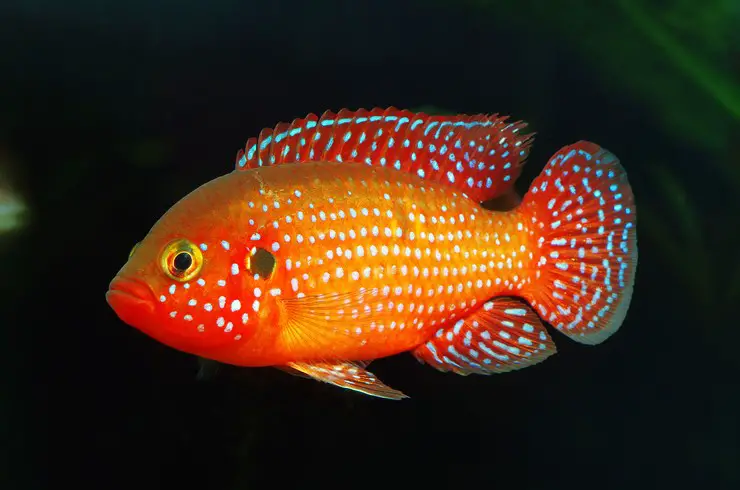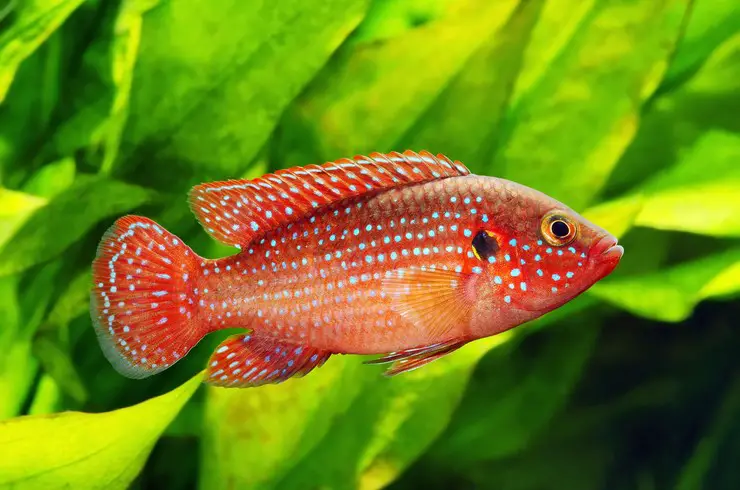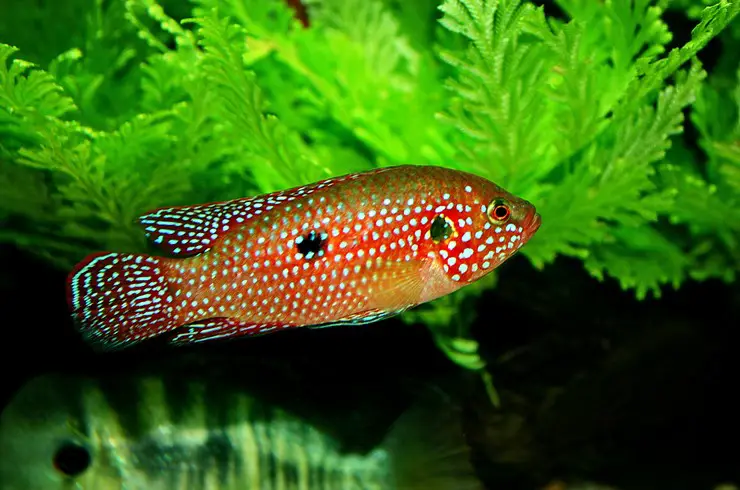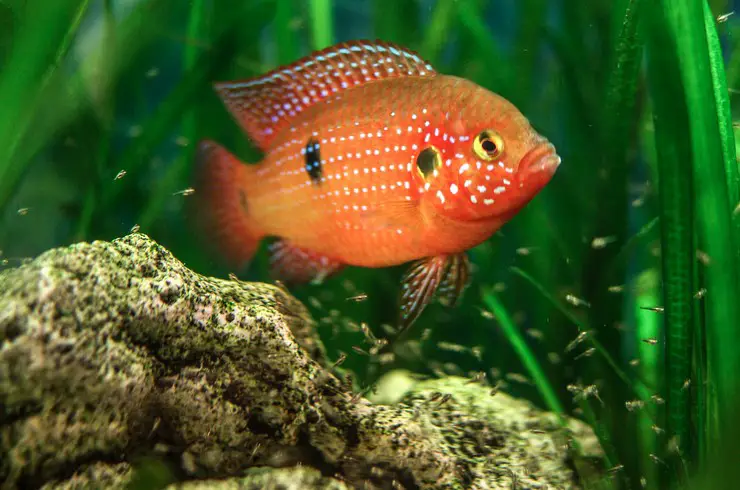Many cichlids are native to Africa and have a very colorful Orkasca. This is believed to help identify individuals of their own species. The handsome Chromis is a real pearl of African waters and it is about this fish that you can learn from our article.
General information
The handsome chromic (Hemichromis bimaculatus ) can be characterized in two words – beauty and aggressiveness. It is not for nothing that in Western countries it is called a “precious cichlid” – a treasure cichlid. Indeed, this is one of the most attractive fish, but it is necessary to carefully select neighbors for cohabitation with it. The fish becomes especially dangerous during the spawning period. But its beautiful appearance will not leave anyone indifferent, so the army of fans of this African cichlid does not decrease over the years.
Appearance
Chromis is colored red, some individuals are bright purple. Scattered all over the body and fins are bluish-green dots that flicker in the light, giving the illusion of gemstone sparkle. On the side in the middle of the body, as well as behind the operculum, a black spot may be located. The maximum size in an aquarium is 15 cm. Gender dimorphism is not pronounced; it is possible to distinguish a female from a male-only after the formation of a pair.
Habitat
You can meet the handsome Chromis in nature in a wide area of West Africa – from South Guinea to the central part of Liberia. The fish is found in the Congo basin and the lower course of the Nile. Chromis prefers slow-flowing rivers and streams with dense vegetation of aquatic plants.
Care and maintenance
The minimum volume for containing a pair of Chromis is 60 liters. The most interesting option is to plant two pairs of fish in an aquarium of 120 liters and watch how they divide the territory among themselves. Large, tall driftwood that divides the aquarium into two halves can help in this.
It is best to choose large pebbles as a soil: Chromis – those who like to dig the bottom.
In the aquarium, it is necessary to provide high-quality filtration and aeration. Weekly water changes of 25-30% are required.
Plants with delicate leaves are incompatible with Chromis, they will pluck and eat them. If necessary, it is better to use anubias, cryptocorynes, elodea.
Compatibility
Unfortunately, the handsome Chromis is a rather quarrelsome fish. The best recommendation would be to keep it in a species aquarium. Cichlids – black-striped, acars, biocelatums can become its neighbors in a common aquarium. They get along well with the cichlids of the African Great Lakes, with the exception of the Mbuna group. Can also be kept with large catfish: pterygoplicht, cynodonts. Chromis often coexist peacefully with large barbs. 
Feeding the handsome Chromis
For proper development and excellent appearance, it is recommended to feed handsome Chromis with complete dry food for cichlids. They are fully balanced, containing all the essential nutrients and vitamins, as well as functional additives that improve digestion and enhance color.
Tetra’s assortment includes a special series of Tetra Cichlid food for cichlids, which is perfect for feeding handsome Chromis. The shape and size of the food must be matched to the age and size of the fish. Chromis perfectly eat both foods floating on the surface and slowly sinking to the bottom, you can choose any convenient form: flakes (Tetra Cichlid XL Flakes), granules (Tetra Cichlid Granules), or sticks (Tetra Cichlid Sticks).
In order to maintain a rich, bright color, it is necessary to include in the diet food with a high content of natural color enhancers: Tetra Cichlid Color, TetraPro Color, or Tetra Rubin.
Do not forget to add the plant component. Highly nutritious TetraPro Algae chips or Tetra Cichlid Algae double-sided balls will fully satisfy the plant food requirements of Chromis due to their high spirulina content.
It is necessary to feed adult Chromis 1-2 times a day with such a portion of food that will be eaten in a few minutes. Fry need 3-6 feeds per day.
Reproduction and breeding
The biggest challenge when breeding Chromis is finding the right sires. Gender dimorphism in fish is not pronounced; it is possible to identify the male and the female-only after the formation of pairs. The second problem is related to the fact that it is necessary to choose a female that is suitable for a particular male. Very often, conflicts arise in a pair, and the fish can kill each other. Therefore, the first time when forming a pair, you must carefully monitor the behavior of the fish.
If the partners have approached each other, then soon enough offspring can be expected. It is worth noting that Chromis are monogamous and remain mated for life. When the male prepares for spawning, his coloration becomes even brighter.
The female lays up to 500 eggs on a flat stone or other suitable decoration. Incubation lasts about two days, after which the larvae appear. The female carefully transfers them to another place while they feed on the yolk sac. Young Chromis are ready for independent feeding within three days after hatching. The fish have a very developed parental instinct. Both the female and the male will attack with lightning speed any stranger who invaded their territory.
The individual fry grows faster than others and is able to eat their congeners, so regular sorting is necessary until the fish grow to a size of 1 cm. At the same time, it is necessary to transplant the parents.

